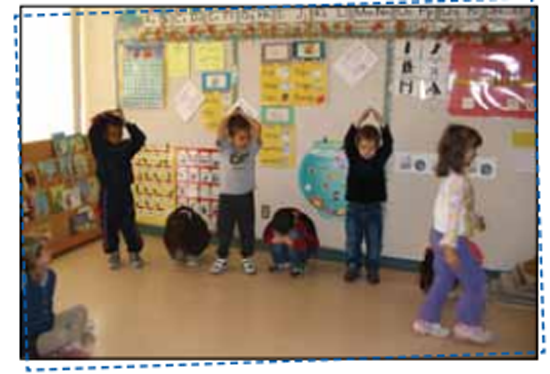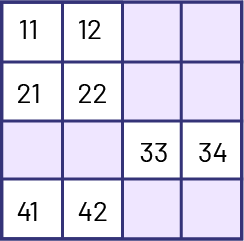C1.3 Determine pattern rules and use them to extend patterns, make and justify predictions, and identify missing elements in patterns represented with shapes and numbers.
Skill: Determining and Using Rules to Extend Patterns
Understanding Change
Students live in a changing world and it is important for them to make these connections (for example, each year their height and weight increases and their feet grow in length). Understanding what changes and what remains constant is foundational in developing algebraic thinking. Observed changes can be described qualitatively (for example, I am taller than last year; my hair is longer; the bucket filled with water quickly during the storm; it is colder than this morning) and quantitatively (for example, I grew 2 cm this year; the bucket of water filled with 50 ml in 30 minutes; the temperature dropped 6°C in 3 hours). Students need to learn to observe and make sense of what can change in a pattern.
Patterns with Repeating Operations

By examining the change from one shape to the next, students can identify a pattern.
Source: translated from Guide d’enseignement efficace des mathématiques de la maternelle à la 3e année, Modélisation et algèbre, Fascicule 1, Régularités et relations, p. 21-22.
The main goal is to develop students' algebraic reasoning by enabling them to justify the extension of a non-numeric or numeric pattern and to explain the relationships that exist between the terms of the pattern.
Source: translated from Guide d’enseignement efficace des mathématiques de la maternelle à la 3e année, Modélisation et algèbre, Fascicule 1, Régularités et relations, p. 27.
Relationships Between Terms
Using a variety of representations and materials, students explore the relationships between the terms in a pattern and use this information to determine how a pattern can be extended.
Students continually redefine their mental image of patterns. Their representation is often limited by the examples they are presented with or by their personal experiences. It is therefore important that teachers share a variety of representations of patterns and support students in understanding their rules.
Source: translated from Guide d’enseignement efficace des mathématiques de la maternelle à la 3e année, Modélisation et algèbre, Fascicule 1, Régularités et relations, p. 27.
Non-numeric Patterns
In order to extend a pattern, students must recognize the elements of the pattern and determine their order. By extending a pattern while justifying their choice, students communicate their understanding of what the pattern rule is; for example, a student may say, "I'm going to be the sailboat because right before me is the balloon, and the pattern is always sailboat, balloon, sailboat, balloon repeating."

Using their bodies or manipulatives, students can explore the extension of a pattern and make changes more easily. They can also extend a pattern that others have constructed.
Source: translated from Guide d’enseignement efficace des mathématiques de la maternelle à la 3e année, Modélisation et algèbre, Fascicule 1, Régularités et relations, p. 38.
Number Patterns
Very early on, students become aware of regularities in their environment, in nature, in the objects around them. This is why it is possible to introduce them to number patterns as early as Grade 1. At the same time, students develop a sense of number, can count in intervals and backwards, and eventually acquire the concept of addition as a grouping of objects. All of these concepts have an important connection to learning number patterns.
Exploring the base ten numbering system, synonymous with the decimal system, allows students to discover that there is a repetition of digits from 0 to 9 in counting beyond 9 (10, 11, 12, 13, 14, 15…). Seeing and justifying this regularity in the decimal system improves their understanding of number sense and groupings (units, tens, hundreds, etc.). For example, by counting in increments of 2, starting at 16, students observe a predictable pattern in the numbers (16, 18, 20, 22, 24, 26, 28, 30, 32…). This is a first step toward exploring multiples of 2. This understanding also leads them to develop the ability to count from any number using any leap.
Similarly, when students count by 5s, they quickly recognize a pattern, that is, that the units digit alternates between the digit 0 and the digit 5 (5, 10, 15, 20). They can generalize this discovery informally by saying that any number that is a multiple of 5 will end in 5 or 0.
It may be helpful for teachers to offer students the opportunity to identify patterns in a number grid to help them develop their conceptual understanding of number and the base ten numbering system.
Source: translated from Guide d’enseignement efficace des mathématiques de la maternelle à la 3e année, Modélisation et algèbre, Fascicule 1, Régularités et relations, p. 49-50.
Skill: Making Predictions and Justifying Them
The use of concrete and visual (semi-concrete) materials and a variety of representations and rules allows students to make and justify near and far predictions.
Making a close prediction is to indicate what the next term or couple of terms in a given pattern will be. The prediction can be verified by extending the pattern.
Making a far prediction involves indicating what a distant term in a pattern will be. Understanding the relationship between the position number and the corresponding term value is key. Often, calculations are necessary to ensure the prediction is accurate or to check its plausibility.
Source: Ontario Curriculum, Mathematics Curriculum, Grades 1-8, 2020, Ontario Ministry of Education.
Students can best describe a pattern when they understand the relationship between each term in the pattern and the position each term occupies in the pattern. They can do this by numbering each term in the pattern in turn.

In this way, students can refer to specific terms in the pattern (for example, in the pattern above, the suns are in the 3rd, 6th, and 9th positions from the left). By analyzing the relationship between the position and the term, it is easy to predict the next terms in the pattern without having to extend it. This analysis allows students to generalize (for example, a sun will be in the 12th position, since it is in the 3rd position of each pattern. The position of the sun is always a multiple of 3).
In the problem situation "How many suns are needed to complete 10 patterns in this pattern?", elementary students can informally discuss, model and create multiple representations, describe them, and conclude by identifying the number of suns needed and justifying their approach. Exploring this type of problem allows students to develop their algebraic thinking and serves as a foundation for using a rule and variables in future grades.
Source: translated from Guide d’enseignement efficace des mathématiques de la maternelle à la 3e année, Modélisation et algèbre, Fascicule 1, Régularités et relations, p. 38-39.
For example, in carefully analyzing a pattern, students see that the shape in the 1st term has two geometric shapes, the shape in the 2nd term has four, the shape in the 3rd term has six, etc. Students see that there are always twice as many geometric shapes as the position of the shape. This observation, the matching rule, allows them to find any term in the pattern without having to extend it.
Informal discussions dealing with the relationships between shapes and the number of elements in them can occur by determining the rule and extending the pattern.
Source: translated from Guide d’enseignement efficace des mathématiques de la maternelle à la 3e année, Modélisation et algèbre, Fascicule 1, Régularités et relations, p. 45-46.
Skill: Finding Missing Terms in Patterns
In non-numeric and numeric patterns, students need to determine what is in a predetermined position (before, after, or within the pattern). Therefore, they need to determine the pattern rule and then identify the missing shape or number.
Example
Find the 2nd term of the following growing pattern.

Source: translated from En avant les maths! 2e, CM, Algèbre, p. 4.
The study of regularities in a number pattern can be continued using a number grid or number line with missing numbers. Students must first find the rule in order to discover the missing numbers, and then explain the addition or subtraction pattern rule. The calculator can be helpful in solving these types of problems.
Examples
Missing Numbers in a Partial Number Grid

Missing Numbers on an Open Number Line

Source: translated from Guide d’enseignement efficace des mathématiques de la maternelle à la 3e année, Modélisation et algèbre, Fascicule 1, Régularités et relations, p. 67.
Knowledge: Pattern Rules
Recursive Relationship: a rule that allows a pattern to be extended with respect to the difference between terms (also called a constant jump).
Source: Ontario Curriculum, Mathematics Curriculum, Grades 1-8, 2020, Ontario Ministry of Education.
Functional Relationship: a rule that extends a pattern by establishing the relation between the term number or position number and its term value.
Source: translated from Curriculum de l'Ontario, Programme de mathématiques de la 1re à la 8e année, 2020, Ministère de l'Éducation de l'Ontario.
